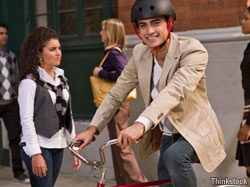(ARA) – Bicycling for fun, exercise and to commute to work is exploding throughout the United States. In fact, according to the U.S. Census Bureau, the number of Americans biking to work has increased 43 percent between 2000 and 2008.
As the popularity of biking rises, an increasing number of cities and states are taking notice, creating new bicycle-only trails, designing commuter routes for bicyclers, and reviewing and creating new laws and regulations in support of bicyclers.
While bicycling is fun for all ages, provides immense health benefits, reduces commuting costs and is good for the environment, it also comes with its risks – primarily when cyclists use the same roads as cars. As more cyclists hit the roads, the odds of a collision with an automobile, or even other riders and pedestrians, increases, especially in urban areas.
Here are some tips from Findlaw.com, a leading online source of legal information, about what all bicycle riders need to know:
1. Know your bicycle laws. Many states have specific laws pertaining to operating a bicycle, including laws involving helmets and the use of lights and other safety devices on a bicycle. Cyclists also should become familiar with laws involving the interaction between bicyclists and motor vehicle operators – for example, regulations involving the safe passing of bicyclists by an automobile or motorcycle driver. While some states have enacted bicycle-specific laws – such as riding through red lights when no cross traffic is present – that are designed to protect bicycle riders, it’s important for bicyclists to realize that when car meets bicycle, the car usually wins.
2. Don’t be distracted. Bicyclists need to be focused riders while they are sharing the road. The use of iPod devices and cell phones can distract riders from the road.
3. Don’t drink. Drinking is never safe with any vehicle, and this includes biking. According to the National Highway Traffic Safety Administration, 23 percent of the cyclists killed in 2008 were drunk.
4. Wear a helmet. In response to the alarming rate of bicycle-related deaths caused by trauma to the head, a growing number of states are mandating helmet use, especially among riders 16 and younger. In 2008, 91 percent of the cyclists killed were not wearing a bicycle helmet.
5. Be seen. Besides a bicycle helmet, it’s essential for bicyclists to wear bright clothing with reflective strips or zones to be better seen by car drivers. In addition, cyclists should equip their bikes with front and rear lights and reflectors to enhance visibility during low-light conditions. Cyclists should always carry some sort of identification with emergency phone numbers in the event they’re injured and are unable to call for help on their own.
6. Prevent collisions. Bicyclists should take preventive steps to avoid collisions with motor vehicles. For example, at an intersection, always make eye contact with nearby drivers. If they don’t respond, wave to the driver until you get their attention. When passing parked cars, always ride a few feet away from the open door zone.
7. Let them know you’re coming. A cyclist has every right to be on the road and it is a pedestrian’s responsibility to make sure they are also obeying traffic laws and being safe. Avoid surprising pedestrians and other cyclists by yelling to them before passing, or ringing a bell on blind curves and corners.
8. When a bicyclist is hit. In some states automobile drivers are automatically presumed to be at fault if they strike a bicyclist. However, that may be overturned by evidence of fault on the part of the bicyclist; for example, if the bicyclist was riding at night without a headlight, no reflective gear, etc. When a bicyclist hits a pedestrian or another biker, it’s the responsibility of the biker to remain at the scene and wait until medical attention arrives, if necessary.
9. Biker insurance. Thousands of bicycle riders are injured every year. If you have auto or home insurance, check with your insurance agent to see if that same policy will provide insurance coverage in the event you are riding your bicycle and are in a collision with an uninsured or underinsured motor vehicle driver, pedestrian or another bicycle rider.
10. Road rage happens. Bike often enough and you’ll eventually encounter an angry driver. As the biker, it’s your job to live to ride another day, so it’s in your best interest to avoid a confrontation and instead remember the person’s license plate number and report the driver, especially if you suspect the driver is under the influence.
To learn about the law and for more tips about the aftermath of a bicycling accident, go to Findlaw.com.

